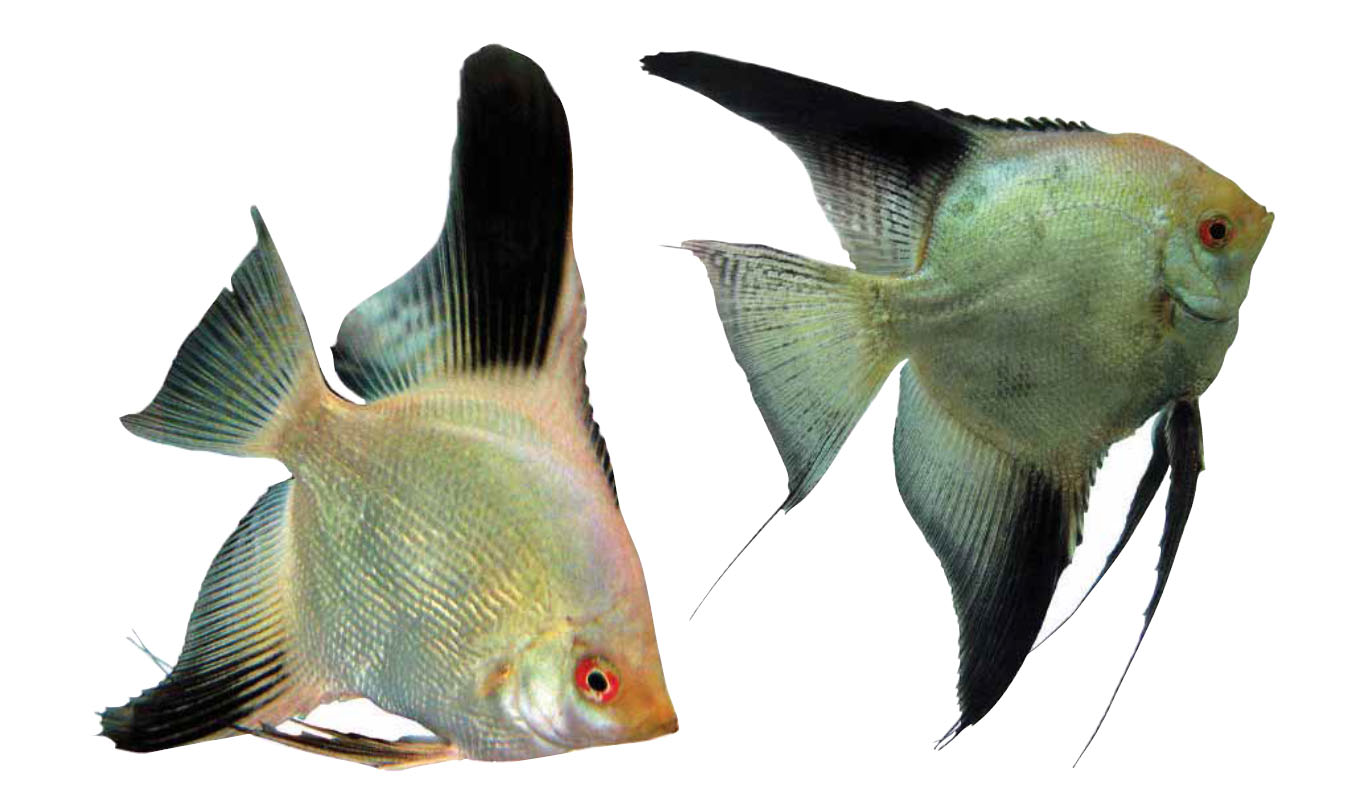
Slavkov’s Bulgarian Green Gene Bulgarian Seal Point Pearlscale at left (D/Gm – S/+ – p/p – bg/bg), and Bulgarian Seal Point (D/Gm – S/+ – bg/bg) – images copyright Raiko Slavkov
In honor of the first importation of “Bulgarian Green” Angelfish genetics into the US by David Labell of AngelfishUSA, we present some background information in this excerpt from “Angelfish: Genetic Transparency Changes Everything” by Matt Pedersen, originally published in the January/February 2013 issue of AMAZONAS Magazine.
The next big [Angelfish] gene?
Perhaps the most interesting new development is the emergence of what some are calling a new mutation, currently termed the Bulgarian Green (bg) gene. This potentially unique mutation was discovered by Raiko and Ilia Slavkov, proprietors of Malavi in Bulgaria, in a phenotype that has been dubbed the Bulgarian Seal Point. Many questions have arisen. Is it really something new? Is Bulgarian Green recessive? Is it on a new locus? Or is it a new allele on the highly complex Dark locus?
Raiko is convinced that what they’ve found is a previously undiscovered recessive gene, exposed through 10 years of inbreeding with Dark Gold Marble (D/Gm) and Hybrid Dark (D/g) lineages. Assuming that our current understanding of the Dark locus and Gold Marble allele is correct, the Slavkovs performed a test cross of a Blushing Bulgarian Seal Point to a wild-type angelfish. The results revealed offspring that had either the Dark allele or the Gold Marble allele, both of which are thought to occupy the Dark locus. Since the Silver angelfish would have neither, the conclusion is that the Blushing Bulgarian Seal Point parent is contributing either a Dark allele or a Gold Marble allele to the offspring of this test cross. Raiko explains, “It is not possible to have a third gene in this locus.” In other words, the allele that drives the Bulgarian Seal Point cannot be on the Dark locus.
Raiko states that “the crosses I’ve made showed that Bulgarian Green is a new recessive gene in a new locus. The effect is that the new gene hides the black color in the body area (stripes, spots, or completely black body) [in] the phenotypes we know. The black color in the area of the fins does not change.”
It has taken a couple of years of breeding, with the capacity of a hatchery, for Raiko to come to these conclusions. It will take hard data provided to the Angelfish Society for the Bulgarian Green gene to be added to the genetic canon. Even if the Slavkovs don’t furnish such data, someone else might. There is a possibility that Bulgarian Green will be the next big gene making its way into the tanks of angelfish breeders; the Slavkovs report that they are selling their angelfish “on the local market,” so there is “no risk of losing the gene.”
A new mutation like Bulgarian Green always starts as a mystery. It is the diligent breeder or amateur scientist who may be able to figure it out and further our understanding of designer angelfishes.
You can read Matt Pedersen’s full article on Angelfish genetics when you buy the back issue.






I would like to more deatails about Bulgarian green
Caring breeding etc
I have. 10 fishes of the same
Please help me
My gold angel female cross breed with blue angel male. What type of fry comes?
Please guide me.
Swapnil – if there are no hidden genetics, the first generation offspring will all appear to be silver, wild-type. Both Gold and Philippine Blue genetics are recessive. Doing the Punet squares, each fry would get a gold gene from the one parent, and a Philppine blue gene from the other. So every fish would be “het”, and we might shorthand it like this +/g – +/pb. Mate those fry together, and you’d get a range of outcomes including wild-type, more golds, more blues, and also platinums, and in some cases the offspring will have hidden genetics beyond what is outwardly observable.
I have manacapuru crossed with a double dark blue Pinoy. I have super veil green Pinoy that I plan to cross. I’m looking for the red saddle back with 18″ fins. Do you think I will accomplish this?